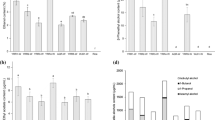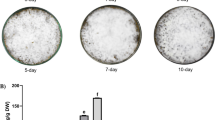Abstract
Red yeast rice which is a product of solid fermentation was prepared from several kinds of Thai glutinous rice (Oryza sativa L.) cv. Korkor 6 (RD6), Kam (Kam), and Sanpatong1 (SPT1). Monascus purpureus CMU001 isolated from available Chinese red yeast rice was used as the fermentation starter. The analysis for the presence and the content of monacolins, the cholesterol-lowering compounds, were carried out using high performance liquid chromatography (HPLC). The presence of the monacolins was confirmed by the retention time of the reference compounds and LC-MS. The results were compared to those obtained from the Chinese red yeast rice and Thai non-glutinous rice (O. sativa L. cv. Mali105). The chromatograms show the presence of monacolin K acid form (MKA), compactin (P1), monacolin M acid form (MMA), monacolin K (MK), monacolin M (MM), and dehydromonacolin K (DMK). A large peak of a compound with the molecular weight of 358 was also detected but could not be identified. The amount of two important monacolins, compactin, and monacolin K, were determined. It was found that the highest amount of compactin and monacolin K were 21.98 and 33.79 mg/g, respectively, when using Thai rice varity O. sativa L. cv. RD6 which was fermented without adding soybean milk.






Similar content being viewed by others
References
Albert AW (1980) Mevinolin: a highly potent competitive inhibitor of hydroxymetylglutaryl-coenzymeA reductase and a cholesterol-lowering agent. Proc Natl Acad Sci USA 77:3957–3961
Brown AG, Smale TC, King TJ et al (1976) Crystal and molecular structure of compactin, a new antifungal metabolite from Penicillium brevicompacum. J Chem Soc 1:1165–1169
Calaf RE, Carrascal M, Gelpi E et al (1997) Quantitative analysis of mevinolic acid in human plasma by high-performance liquid chromatography coupled with negative-ion electrospray tandem mass spectrometry. Rapid Commun Mass Spectrom 11:75–80
Chen F, Hu X (2005) Study on red fermented rice with high concentration of monacolin K and low concentration citrinin. Int J Food Microbiol. http://www.sciencedirect.com/science?-ob=ArticleURL&-aset=V-WA-A-W-AU. Accessed 17 July 2005
Domsch KH (1980) Compendium of soil fungi, vol 1. Academic Press, London
Endo A (1979) Monacolin K, a new hypocholesterolemic agent produced by a Monascus species. J Antibiot 32:852–854
Endo A (1980) Monacolin K, a new hypocholesterolemic agent that specifically inhibits 3-hydoxy-3-methylglutaryl coenzyme a reductase. J Antibiot 33:334–336
Endo A (1985) Compactin (ML-236B) and rerated compounds as potential cholesterol-lowering agents that inhibit HMG-CoA reductase. J Med Chem 28:401–405
Erdogrul O, Azirak S (2004) Review of the study on the red yeast rice (Monascus purpureus). Turkish Electronic J Biotechnol 2:37–49
Gamble SJR, Orcutt FS (1951) Possible use of rose bengal agar as differential medium for the isolation of bacteria in the family Rhizobiaceae. J Bacteriol 62:247
Hajjaj H, Niederberger P, Duboc P (2001) Lovastatin biosynthesis by Aspergillus terreus in a chemistry defined medium. Appl Environ Microbiol 67:2596–2602
Hong MY, Seram NP, Zhang Y et al (2008) Anticancer effects of Chinese Red Yeast rice versus Monacolin K Alone on colon cancer cells. J Nutr Biochem 19:448–458
Insomphun S (2003) Rice (Oryza sativa L.). Faculty of Agriculture, Chiang Mai University, Thailand. http//agronomy.agri.cmu.ac.th/elearning/agron313/rice.doc. Accessed 15 Aug 2008
Iizuka H, Lin CF (1981) On the genus Monascus of Asia and its specific characteristics. In: Moo-Young M, Robinson CW, Vezina C (eds) Advances in biotechnology, vol 2. Pergamon Press, Toronto, pp 555–561
Jarvis B (1973) Comparison of an improved rose-bengal–chlortetracycline agar with other media for the selective isolation and enumeration of molds and yeasts in food. J Appl Bacteriol 36:723–727
Journoud ML, Jones PJ (2004) Red yeast rice: a new hypolipidemic drug. Life Sci 74:2675–2683
Li YG, Zhang F, Wang ZT, Hu ZB (2004) Identification and chemical profiling of monacolins in red yeast rice using high-performance liquid chromatography with photodiode array detector and mass spectrometry. J Pharm Biomed Anal 35:1101–1112
Li YG, Liu H, Wang ZT (2005) A validated stability-indicating HPLC with photodiode array detector (PDA) method for the stress tests of Monascus purpureus fermented rice, red yeast rice. J Pharm Biomed Anal 39:82–90
Lin YL, Wang TH, Lee MH et al (2008) Biologically active components and nutraceuticals in the Monascus-fermented rice; a review. Appl Microbiol Biotechnol 77:965–973
Ma JY, Li YG, Ye Q et al (2000) Constituents of red yeast rice, a traditional Chinese food and medicine. J Agric Food Chem 48:5220–5225
Mandt M (1998) Legal opinion on the use of red fermented rice (Angkaks) in food. Paper collection for a symposium of Monascus cultures and application, Toulouse, France, 8–10 July 1998
Miche J, Balandreau J (2001) Effect of rice seed surface sterilization with hypochlorite on inoculated Burkholderia vietnamiensis. Appl Environ Microbiol 67:3046–3052
Ottow JCG, Glathe H (1968) Rose bengal-malt extract-agar, a simple medium for the simultaneous isolation and enumeration of fungi and actinomycetes from soil. J Appl Microbiol 16:170–171
Pattanagul P, Pinthong R, Phianmongkhol A et al (2008) Mevinolin, citrinin and pigments of adlay angkak fermented by Monascus sp. Int J Food Microbiol 126:20–23
Pinthong R, Bipong S, Raviyan P (2004) Effect of monosodium glutamate and histidine on the production of red pigment and citrinin in red yeast rice. Chiang Mai University, Thailand (in Thai)
Stubbs RJ, Schwartz M, Bayne WF (1986) Determination of mevinolin and mevinolic acid in plasma and bile by reverse-phase high-performance liquid chromatography. J Chromatogr B Biomed Sci Appl 383:438–443
Su YC, Wang JJ, Lin TT et al (2003) Production of the secondary metabolism γ-aminobutyric acid and monacolin K by Monascus. J Ind Microbiol Biotechnol 30:16–41
Trenin AS, Katruhha GS (1997) Antibiotics inhibiting the biosynthesis of cholesterol (a review). Pharm Chem J 31:5–16
Van Tieghem M (1884) Monascus genre nouveau de l’ondre des Ascomycetes. Bull Soc Bot France 31:226–231
Wang J, Lu Z, Chi J et al (1997) Multicenter clinical trial of the serum lipid-lowering effects of a Monascus purpureus red yeast rice preparation from traditional Chinese medicine. Curr Ther Res 58:964–978
Went FAFC (1895) Monascus purpureus, Le champignon de l ‘ang-quac, une nouvelle thelebolee. Ann Sci Nat Bot Ser 81:1–18
Yongsmith B (1997) Microbiology of vitamin and pigments fermentation, 1st edn. Kasetsart University, Thailand (in Thai)
Acknowledgments
The authors would like to acknowledge the Faculty of Science, Chiang Mai University, for providing all facilities and materials to do the research work. We also would like to thank the Graduate School of Chiang Mai University and Rajamangala University of Technology Lanna for a part of financial support. We would like to express the best thanks to Dr. Boonsom Bussaban for taking the photographs of M. purpureus.
Author information
Authors and Affiliations
Corresponding author
Rights and permissions
About this article
Cite this article
Chairote, Eo., Chairote, G., Niamsup, H. et al. The presence and the content of Monacolins in Red Yeast rice prepared from Thai glutinous rice. World J Microbiol Biotechnol 24, 3039–3047 (2008). https://doi.org/10.1007/s11274-008-9850-z
Received:
Accepted:
Published:
Issue Date:
DOI: https://doi.org/10.1007/s11274-008-9850-z




